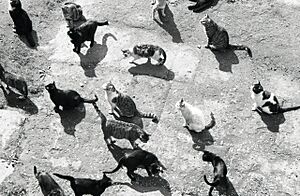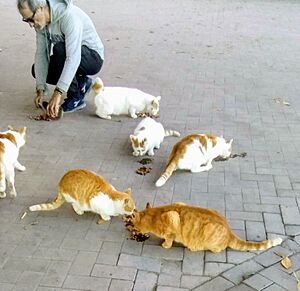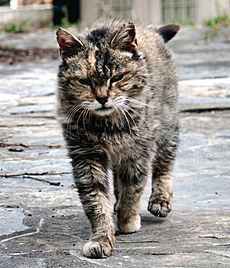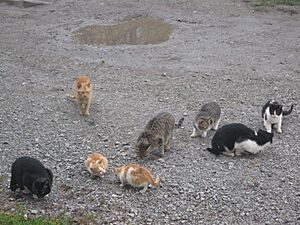Feral cat facts for kids
A feral cat is a domestic cat that lives outdoors without an owner. These cats usually avoid people and stay hidden. They don't let humans touch them. Feral cats can live for many generations in the wild. They can become strong hunters in cities, grasslands, and forests.
Some feral cats might get a bit more comfortable with people who feed them regularly. But even with a lot of effort to make them friendly, they usually stay shy. They are most active after the sun goes down. Out of about 700 million cats worldwide, around 480 million are thought to be feral.
Feral cats can cause a lot of harm to wildlife. Experts who study nature see them as one of the worst invasive species on Earth. This means they are not native to an area and cause damage. Many efforts are made to control feral cat numbers. These efforts often work best in special fenced areas.
Some groups that protect animals suggest programs called trap-neuter-return (TNR). In these programs, feral cats are caught, given a surgery so they can't have kittens, and then returned to where they were found. However, science shows that TNR programs are not very good at controlling the overall number of feral cats.
Contents
What is a Feral Cat?

The term feral cat can mean different things to different people and in different countries. Sometimes, people use other words like free-roaming, street, or community cat. These terms can also refer to stray cats. However, most animal rescuers, veterinarians, and researchers see stray cats and feral cats as different.
A stray cat is usually a pet that got lost or was abandoned. It might still be used to people. A feral cat has lived in the wild for a long time and is very afraid of humans. It's not always easy to tell the difference between a stray and a feral cat.
Some animal activists try to call feral cats "community cats." They want people to see these cats as a normal part of the environment. But scientists say this new name hides the fact that feral cats can be a big problem for nature. They also say it wrongly suggests that communities agree to have many feral cats around. Studies show that most people don't want large numbers of free-roaming cats outdoors.
Feral Cats Around the World
In the United Kingdom, a feral cat is one that avoids humans. It survives on its own and will hide or fight if caught. Rescuers and vets think a cat is feral if it didn't have much human contact before it was eight weeks old. These cats prefer to run away rather than attack.

In Italy, feral cats have been protected by law since 1991. It is against the law to kill them there.
In the United States, there isn't one clear definition of a feral cat. Many animal shelters watch cats for a while to see if they become less scared. They also look at how a cat reacts to being touched or how it acts around people.
In Australia, the government says cats that have no human contact are feral. Cats that rely on humans but don't have owners are called semi-feral or stray. Even these "managed colonies" can harm wildlife. For example, they have caused native animals like numbats to disappear in some areas.
Farm Cats
A farm cat is a free-roaming domestic cat that lives in a group on farms. They usually live outdoors and sleep in barns. Farmers might give them some food and milk. But farm cats mainly hunt rodents like rats and mice. In England, most farms have farm cat groups, some with up to 30 cats. Female farm cats often help care for kittens from other cats in the group.
Some animal rescue groups have "Barn Cat Programs." They find new homes for spayed or neutered feral cats with people who want cats for their barns.
Ship's Cats
Cats have been part of ship crews for a very long time, since the beginning of trade by sea. Ancient traders probably took cats on their ships to Italy and the Mediterranean islands. Cats were useful for catching rodents on board.
History of Feral Cats
Cats in ancient Egypt were highly respected because they killed rodents and dangerous snakes. People probably first tamed cats to protect their stored grain crops from rodents. Cats are thought to have spread from Egypt to many parts of the world.
Phoenician traders brought cats to Europe to help control rat populations. Later, monks took them further into Asia. Roman armies also helped spread cats, eventually bringing them to Britain. Since then, cats have continued to be introduced to new countries, often by sailors or settlers. For example, cats likely arrived in Australia in the 1600s or late 1700s. These pet cats then started to form feral groups when their kittens began living away from humans.
In the 1800s and 1900s, some cats that were thought to be wildcat types are now considered feral cats. For example, the Sardinian wildcat and Corsican wildcat are now believed to be descendants of domestic cats brought to those islands long ago.
Where Feral Cats Live
Feral cats are the most widespread land carnivore (meat-eater) in the world. They live in many different climates and on islands in the Atlantic, Indian, and Pacific Oceans, and the Mediterranean Sea. This includes places like the Canary Islands, Galápagos Islands, and Hawaiian Islands.
Feral cat groups also live on Japanese islands such as Ainoshima and Aoshima, Ehime. The feral cat population on the Hawaiian Islands mostly came from Europe, probably arriving on ships in the 1800s.
Feral cat groups in Rome have been watched since 1991. Scientists have also studied urban feral cats in cities like Madrid, Jerusalem, and Ottawa.
How Feral Cats Behave
Feral cats usually avoid humans. They don't let people touch them and will run away if they can. If they are caught, they might hiss, growl, or try to scratch. They usually stay hidden from people and won't come close. However, some feral cats might slowly become more comfortable around people who feed them regularly.
Most feral cats stay in a small area. Male cats usually have a larger area than female cats, but it's still often less than 10 hectares (about 25 acres). This area can change based on breeding season, age, time of day, and how much food is available.
Feral cats need human settlements to survive. They live in cities, suburbs, and farms where they can easily find food or prey animals. You won't find many feral cats far away from human homes. Even though they hunt small animals, their home areas don't change much with the seasons. This shows that they have a fairly steady home range. They move more because of finding mates, regular food from humans, or other reasons.
Feral Cat Colonies
Feral cats often live in groups called colonies. These colonies are usually found near food sources and shelter. Scientists have different ideas about how these groups are organized. Some colonies have a clear leader, while others have more complex social rules.
A 'managed colony' is a group of cats cared for by humans. These people provide food, water, and shelter. They also arrange for vet care and trap-neuter-return programs. They try to find homes for cats that can become pets and teach people in the area about feral cats.
Feral cats are known to move between colonies if their territories overlap. Also, the number of cats in a colony can change. Some cats might leave their family homes to join a colony. And some feral or semi-feral cats might get used to living with humans and become pets.
Making Feral Cats Friendly
Young feral kittens can be caught and made friendly enough to be adopted into homes. Experts don't fully agree on the exact age when a kitten becomes too old to easily socialize. But it's usually thought to be between seven weeks and four months old. While older cats can sometimes be made friendly, it's a very long and hard process. The cat might still remain fearful and not become truly friendly.
In a 2013 study in Britain, animal rescuers were more willing than vets to try to tame adult feral cats. Vets were often against it. They worried about how a wild cat would live in a home. A 2010 survey in the United States found that 66% of vets and rescuers had programs to socialize kittens. Only 8% had programs for adult cats.
In Parañaque, Philippines, people praised the building of special wooden "Cat Homes" for stray cats.
What Feral Cats Eat
Feral cats are either mesopredators (mid-level hunters) or apex predators (top hunters) in their local areas. They hunt many different kinds of animals, both with backbones (like mammals and birds) and without (like insects). They usually prefer smaller animals that weigh less than 100 grams (about 3.5 ounces). Their favorite prey includes mammals, birds, and lizards. Globally, they are known to hunt over 1,000 different species. The most common prey are house mouses, European rabbits, black rats, house sparrows, and common blackbirds.
In Australia, feral cats hunt animals that were brought there, like European rabbits and house mice. They also hunt native rodents and marsupials, especially the common ringtail possum.
In the United States, some people think feral cats help control pigeons and invasive rodents like house mice and brown rats. However, these common rodents have lived with cats for a long time in human areas. This means they are better at avoiding cats than native rodents. Studies in California showed that 67% of the mice killed by cats were native species. Areas near feral cat colonies actually had more house mice, but fewer birds and native rodents.
Even though cats usually hunt animals smaller than half their size, a feral cat in Australia was seen hunting an adult pademelon. This animal weighed about the same as the cat, around 4 kilograms (9 pounds).
African feral cats have even been seen drinking milk directly from elephant seals.
Who Hunts Feral Cats?
Feral cats can be hunted by other animals. Their predators include feral dogs, dingoes, coyotes, caracals, and large birds of prey.
Health of Feral Cats
How Long They Live
Feral cats in managed colonies can live long lives. Many cats in managed colonies in the United Kingdom have died of old age.
A long study of a trap-neuter-return (TNR) program in Florida found that most cats (83%) had been in the colony for more than six years. Almost half of them were first seen as adults, so their exact age was unknown. This was compared to a 1984 study that found pet cats lived for an average of 7.1 years.
Diseases
Types of Diseases
Feral cats, like all cats, can get many diseases and infections. These include rabies, toxoplasmosis, and feline panleukopenia virus. They can also get external parasites like fleas and internal parasites like worms. Other diseases include feline immunodeficiency virus (FIV) and feline leukemia virus (FeLV). These two viruses weaken a cat's immune system, making them more likely to get other infections. Cats can also get skin infections like ringworm and respiratory illnesses.
How Diseases Spread to Humans
The Centers for Disease Control and Prevention (CDC) has warned about the risk of rabies from feral cats. Since the 1970s, when efforts to control rabies in dogs began, cats have been the main animals spreading rabies to humans in the United States. In 2010, 303 rabid cats were reported in the U.S. Some colony management programs give rabies vaccines to cats. But cats need to be revaccinated every few years, which is hard to keep up with. Also, without proper records, contact with a vaccinated feral cat might still require medical treatment for humans.
A study of feral cats on Prince Edward Island warned about a "considerable zoonotic risk." This means there's a risk of intestinal parasites spreading from cats to humans. The study noted that while they didn't find strong evidence of a big risk from T. gondii in cats, the risk should still be considered. This is because this infection can cause serious health problems in humans. Cats that don't normally spread the parasite can start shedding it when they are stressed.
How Feral Cats Affect Wildlife
In the United States, free-roaming cats kill between one and four billion birds and six to 22 billion mammals each year.
In Australia, domestic cats were brought in during the 1800s to control rabbits, mice, and rats near mining sites and farms. Feral cats in Australia kill about one million reptiles every day. It's estimated they kill more than 800 million mammals each year. Of these, 56 percent are native Australian species.
Impact on Prey Animals
Not much scientific data is available to show how much cat hunting affects animal populations outside of farms. Even well-fed pet cats may still hunt and kill. They mostly catch small mammals, but also birds, reptiles, amphibians, fish, and insects. Cat hunting might be causing bird numbers to drop in cities, but this is still debated.
Feral cats can cause native species to become endangered or even extinct. When non-native cat populations are controlled or removed, native animals can recover quickly.
Native animals like the New Zealand kākāpō and the Australian bettong are often not used to predators like cats. This makes them very vulnerable. Feral cats have had a huge impact on these native species. They have played a big role in many species becoming endangered or extinct. In Hawaii's remote mountains, feral cats destroy the nests of seabirds like Newell's shearwater and the Hawaiian petrel.
On farms, cats can be good at keeping mouse and rat numbers low. But this only works if places where rodents hide (like tall grass) are kept clear. While cats can stop rodent populations from exploding, they are not good at getting rid of very large existing infestations. In places where wildlife is threatened by both rats and cats, there's a worry that controlling cats could lead to more rats, which would then hunt more. For example, on Christmas Island, it was shown that fewer cats would help a threatened bird species grow. But only if rat numbers didn't increase by more than 77 rats for every cat removed.
Mixing with Wildcats

Feral cats have bred with wildcats in many parts of the world. The first time this was reported was over 200 years ago. Scientists don't fully agree on how important this mixing is. Modern genetic studies show that the African wildcat is the ancestor of the domestic cat.
It's unlikely that there are any pure Scottish wildcats left. But the wildcat population there is still different enough from domestic cats to be worth protecting. A lot of mixing has made it hard to tell pure wildcats from feral and domestic cats. This can make conservation efforts difficult. Trap-neuter-return programs have been started to try and stop this mixing.
Mixing of genes from domestic cats into European wildcat populations also happens in Italy, Hungary, Spain, and Portugal.
See also
 In Spanish: Gato cimarrón para niños
In Spanish: Gato cimarrón para niños




